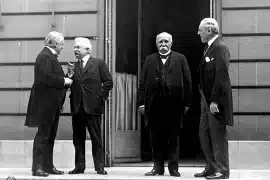Amid the pervasive heart-rending antagonism, I set myself to sing the anthem of syncretism. May the muse of concord be on my side! Right after giving up our mother in immersion [Visarjan], we embrace our neighbors as brothers – and thus never fall short of feeling the need for concord. Many, many year ago, we, Hindus and Muslims together, cast away our motherland, our mother in the field of Plassey and drowned her in the Bhagirathi River. Mother never rose from her immersion – and God knows when she will, if ever. But motherless as we are, won’t we ever have the day of Vijaya for getting one another in fraternal embrace? Will we always keep mouthing the labels Kafir and Yavana and face away from one another?
Those who are exercising the minds of the people of the country in repeating these deadly exorcist spells do not know what indelible harm they are wreaking on the nation. Yet, these spells were not always in the mouths of people. Through the ages, people have passed their lives side by side, offering sweets at the shrines of the Pirs , making vows in the sites of the tutelary goddesses [Thakurani], and living in peace, bonding with each other in fraternal and avuncular ties. Those who are setting the fire of strife to the tradition of peaceful concord out of their narrow, vested self-interest will not be spared: in the long run, time will not miss or err in meting out their due. Those who are banking on the false Semitic idea that God is awfully jealous who takes umbrage whenever someone offers devotion to the Pir or the Thakurani, are either mistaken, or they are deliberately making up a false account of the infinite, immutable, all-pervasive, and perfect Being to serve their narrow, vested interests. All creation emanates from the boundless, expressive essence and is ever immersed in, immanent, ingrained, and suffused with the same. Is there any way to surpass or bypass Him? No matter where you offer your devotion or make your offering, it makes its way to His holy feet. The Upanishad says: ‘Ishabasamidang Sarbang Yatkincajagatyang Jagat’ – the all-pervasive, immanent presence of God in the phenomenal world is attested by the seekers of all places and times. Kabir says, I fear to call Him by name; my tongue freezes in speaking of my sorrow to Him. That is how He is realized in his distinctness from us. If I set out for Lahore being all the while in Lahore itself, it would be nothing but the fool’s adventure . That is why Madan Sheikh , the Baul of Eastern Bengal sang:
O Lord, your way is blocked off by the temple and the mosque,
And even if I manage to find my way, the Guru and the Murshid still get in the way,
Your way is blocked by the temple and the mosque.
I am reminded of the Shuja Mosque in Comilla built by Govinda Manikya, the king of Tripura. Sultan Shuja , the ill-fated son of the Emperor Shah Jahan took refuge in Arakan. At that time, the noble-hearted Govinda Manikya – ousted from the throne by his brother Nakshatra Roy – was also passing his days in the asylum granted by the King of Arakan :
The King Govindya Manikya had been in the land of the Roshangs ,
Meanwhile, Shuja Badshah had a conflict with his brother over the throne,
As Aurangzeb managed to become the Emperor,
Having lost his realm, Shuja went to Roshang.
While Govinda Manikya was in attendance,
Shuja Badshah showed up in the court.
The Kings of Tripura and Arakan were seated on thrones;
Seeing the Badshah, the King of Tripura immediately rose to his feet.
Coming down from his throne,
The King of Tripura greeted Shuja Badshah and ushered him to sit on the throne.
The great king of Roshang inquired of him,
Pray, why have you ceded the throne to the Mleccha King?
The King said, O Lord of men, if you allow,
Why, this is none other than Shuja Badshah, of world renown.
There are plenty more kings like you or me in the world,
Shuja’s realm has room enough to retain scores of such kings.
Being his servant, I cannot remain seated in his presence.
And the King of Tripur sat on another throne.
Examination of the coins of Govinda Manikya and Nakshatra Roy or Chhatra Manikya reveals that Govinda Manikya ascended the throne in Saka era 1581. Just after one year of his reign, he was ousted and Chhatra Manikya ascended the throne in Saka era 1582. Saka era 1581 = 1659 AD; Saka era 1582 = 1660 AD. According to Rajmala, the history of Tripura , when Govinda Manikya ascended the throne, his younger stepbrother Nakshatra Roy went to the court of Sultan Shuja to press charges against Govinda and having received the Sananda [appointment ordinance] from Shuja, he proceeded to capture the throne of Tripura. Govinda Manikya, noble-hearted as he was, had no heart for a clash with his brother. He vacated the throne and moved to Arakan and obtained asylum granted by the King of Arakan.
Examination of Shuja’s history allows us to ascertain the date of this event. On January 3, 1659, having been routed in the Battle of Khajwa, Shuja had to beat retreat from Bengal. For more than one year in Rajmahal and Tanda at the border of Bengal and Bihar, Shuja tried to block the passage of Mir Jumla, the commander of Aurangzeb. After incessant warfare, he was defeated and finally on April 6, 1659, he was forced to evacuate Tanda and he headed for Dhaka. On May 12, he boarded an Arakanese ship in Bhulua and set sail for Arakan. Meanwhile, Mir Jumla and the Mughal forces faced a whole host of dangers and twists of fate and on June 8, 1659, Muhammad, the son of Aurangzeb and ally of Mir Jumla, changed sides and joined hands with Shuja, which severely weakened Jumla’s side and bolstered that of Shuja. It seems plausible that as this year-long conflict embittered Shuja’s heart against his brother, Nakshatra Roy got his way by pleading against his brother Govinda Manikya. The severe financial strain faced by Shuja and the Nazar offered by Nakshatra Roy is also reckoned as a major reason of his success. In any case, at the end of 1659 AD/ Saka era 1681, Govinda Manikya vacated the throne for his brother and took shelter granted by the King of Arakan. After six months, the author of his dethronement, Shuja, also suffered the same fate of having to seek refuge in the same haven. I have already quoted the scene of the meeting between the two at the court of the King of Arakan.
One cannot but admire at the treatment the great-hearted exile King Govinda Manikya accorded to his former oppressor turned today’s fellow partaker in misfortune. The respectful behavior of Govinda Manikya to Shuja also elevated the latter’s standing in the eyes of the King of Arakan. Shuja got married to a daughter of the King of Arakan. As a token of friendship, Shuja presented Govinda Manikya with a precious sword called Nimcha and a diamond ring. Thus friendship was cemented between the oppressor and the oppressed.
Rajmala contains interesting account of the ultimate fate of Shuja. Sir Jadunath Sarkar probably was not aware of this source when he was writing his celebrated history of Aurangzeb; because in his account of Shuja in the second volume of his book, he could not come to a definitive conclusion about what befell Shuja in the end. He discussed all the accounts available from the Mughal and Dutch sources, but did not even mention Rajmala. The account given by Sir Jadunath Sarkar mentions that Shuja left for Arakan with around 40 men in retinue. Among them there were 10 Sayyids of Barha, 12 Mughals, while the rest belonged to the servant class. Having reached Arakan and ensconcing himself into a fairly respectable position in the Arakan court, Shuja got embroiled in a conspiracy to capture the throne of Arakan. However, having been caught in the act, he was murdered by the soldiers of the King of Arakan. However, the account available in the documents of the Dutch Factory shows that Shuja set fire to his own house and taking advantage of the chaos, he fled to Tripura and escaped capture. Mr. Harvey , the author of the History of Burma , also wrote that, after setting fire to the city, Shuja was captured during his flight and killed. (Harvey, History of Burma, p. 147).
The account of Rajmala in this regard certainly deserves a hearing:
The Badshah married the princess of Roshang,
At that point, evil ideas sprouted in the mind of Shuja Badshah.
Forming a scheme to eliminate the king of Roshang,
He deployed 40 soldiers.
They put on Angajira (?) and rode the palanquins,
With two soldiers in each palanquin.
In one palanquin were 8 Kahar (?) men,
And thus they headed for the royal palace of Roshang,
Telling the guards that the convoy is carrying the princess to the palace.
Thus they crossed the sixth gate without any fear.
As they reached the seventh gate, the guard asked:
Why on earth are so many palanquins coming up?
The guards shut off the gate and made search into the palanquins.
The soldiers came out of the palanquins and began fighting.
All the soldiers were killed in the King’s place.
Shuja Shah sneaked away and fled from the territory.
As the Badshah could not be found, search was made for him.
***
It has to be kept in mind that at this time Govinda Manikya was present in the court of Arakan and was a witness to the above-mentioned events. The account of Rajmala specifies that the retinue of Shuja consisted of 40 men. The event hardened the heart of King of Arakan and thus:
The King told Govinda Manikya,
O Lord of men, please go to your own realm.
Abiding by this request, or rather command, Govinda Manikya went to Chittagong and settled there. After a few years, as Chhatra Manikya died, Govinda ascended the throne of Tripura. Thus, it appears that the account rendered by Govinda Manikya has been incorporated in the Rajmala. Hence, the possibility that Shuja was not captured, rather he managed to flee, is not a lesser one. In any case, the question is not the topic of our discussion today. Our topic is how the Shuja Mosque of Comilla was built.
Rajmala states that:
The Badshah had given the diamond ring in Roshang.
The Maharaja sold the ring, and with the money,
He founded a mosque on the bank of the River Gomati,
And named the mosque after Shuja Badshah.
The King established a town in Shuja’s name,
And thus the town was called Shujaganj [Shujaville].
Govinda Manikya, himself a victim of fraternal discord, empathized with Sultan Shuja, who reached the bitter end of misfortune thanks to fraternal discord. When Govinda Manikya recovered his realm, he arranged for keeping the memory of the ill-starred prince alive. A few days back, when I had gone to the Comilla Session of the Bengal Literary Conference, I felt deeply delighted to visit the temple of friendship embodying the warm-heartedness of Govinda Manikya the Magnanimous. The mosque is in very good condition and well-maintained. Till today, the Tripura Royal Government bears the maintenance expenses of the mosque.
I have given an account of a mosque established by a Hindu. Hindu temples founded by Muslims are not hard to find in Bangladesh either. In the Chandpur subdivision of the Tripura district, there is a Kali image and temple founded by Mirza Hossain Ali, a Muslim devotee. I am sure that the readers can furnish many such examples from their respective areas. There was a mosque in the Nayabari village of Dohar thana of Manikganj subdivision in the Dacca district. It has now been lost to the erosion of the Padma River. My dear friend Shifaul Mulk Mr. Hakim Habibur Rahman Khan collected the impression of the epigraphy on the stone pillar installed in the mosque yard. Reading of the text has rendered wonderful findings. The stone pillar is actually an aqueduct through which water is released. On the top of the pillar there is an image of a lion’s face. On one side, the aqueduct is cut into the stone. On one of the other three sides, there is an Arabo-Persian mixed text, while in the two other sides, there is long Sanskrit text in Bengali script. Having received the kind permission of Mr. Hakim, I am conveying the translation of the wonderful text to the readers.
The text reveals that Haji Bahagal Khan or Bhagal Khan built the ‘mosque and the temple’ in the month of Baisakh in Saka era 1517. He identifies himself as the foot-servant of the Emperor Akbar, servant of Brahmins, and Devakula Kamalprakash Bhaskar, i.e. born in the Deva clan. At the end of the text, he has inscribed a request to the future kings: Preserve this work of mine, I will remain the slave of your slave in my future births.
Unfortunately, we cannot find any other information about Haji Bahagal Khan, the generous founder of the mosque and the temple.
In the Baisakh of Saka era 1517 or late April-early May 1595 AD, Bahagal Khan built the mosque and the temple. It would not be an exaggeration to say that at this time, Mughal rule in Bengal was all but vanished due to the uprising of all the landlords of Bangladesh against Akbar. Sometime before, Mansingh, having been appointed the Governor of Bengal, set out for Bengal on May 5, 1594. After setting up his capital at Tanda, he methodically began putting to work his mission of reining in the landlords. On March 31, 1595, Himmat Singh, a son of Mansingh, seized the Bhusna fort at the western end of Faridpur district from the possession of Kedar Ray. This is why around one month later, Bahagal Khan had to pledge allegiance to Akbar. Otherwise, the Hindus and Muslims of Bengal did not submit to Mughal authority till 1613 AD. They relentlessly fought with the Mughal forces. There is a mosque in Chatmohar of Pabna district that was built at this time by Masum Khan Qabuli, one of the key leaders of the Bengal revolt. In the inscription on the mosque, he declared himself as the Sultan and prayed to God for permanency of his reign.
Let me conclude this brief chapter on syncretism by giving an account of a Persian inscription on an edifice built by a Hindu. The Narayanganj town situated on the bank of Lakshya River near the Dhaka city is well known. Four-five miles north of Narayanganj and around one mile east of Lakshya River there is a village called Champatali. A canal crosses through the village westward and falls into Lakshya. The canal is called Akaler Khal. Legend has it that Isa Khan, the lord of the large tract of land encompassing Dhaka, Mymensingh, and Tripura who was also the primus inter pares among the landlords, dug the canal in the year of a famine to relieve the suffering of people. Later, Lala Rajmal, the […] secretary of a descendant of Isa Khan, built a three-arched large footbridge over the canal for public welfare. The bridge is built of bricks, but in some parts stone is also used.
The Footbridge of Champatali – built by Lala Rajmal, the official of the Dewans of Manwar Khan Bagh [4 miles away from Naraynganj]
The bridge is in use as of today, though the arch at the center has been fractured due to earthquake. The stone inscription of the bridge is preserved in the Dacca Museum today. The Persian inscription shows that, with a view to gaining spiritual merit in the afterlife, Lala Rajmal, the fountainhead of generosity, built the bridge in Hijri 1102, 1690 AD. May the stories of the beneficence of Govinda Manikya, Bahagal Khan, and Lala Rajmal shower the blessings of syncretic union everywhere!
Source:
Desh, vol 6: issue 48, October 14, 1939, pp. 583-85.
[1] Nalini Kanta Bhattasali (1888-1947) was a renowned historian, antiquarian, epigraphist, numismatist, and author. His contributions have shed light on hitherto obscure periods of the history of Sultanic and Mughal Bengali.
[1] The battle between the last independent Nawab of Bengal Sirajuddaula and the English East India Company forces took place on June 23, 1757 in the field of Plassey of Nadia. It marks the watershed with which the British colonization of Bengal began.
[1] The tenth day of Indian lunar calendar when according to Hindu mythology, the goddess Durga achieved victory over the demon. On the tenth day, the image of the goddess is immersed in a water-body.
[1] Islamic appellation denoting a non-believer, which can be a derogatory term.
[1] Hindu appellation that used to refer to the Greeks in the antiquity. In the wake of Islamic invasions, the term began to refer to the Muslims. It can be a derogatory term.
[1] Literally, an elder man. In Islamic tradition, a Sufi master is called a Pir.
[1] A great North Indian Nirguna Bhakti saint of the 15th century.
[1] This echoes with the verses of Lalan Fakir, the Bengali thinker: ‘Rather than being aware of what is at hand, we go for searching in faraway Delhi’.
[1] Sheikh Madan was a Baul of the 19th century. See: M. Anisuzzaman, ‘Some Aspects of South Asian Cultural Traditions,’ in World Conference on Recreating South Asia: Democracy, Social Justice and Sustainable Development, (New Delhi: RIS, 2011), p. 5.
[1] Shah Shuja (1616-1660?) was the son of the Mughal emperor Shah Jahan who served as the Governor of Bengal during 1639-1660.
[1] The king Sanda Thudhamma (r. 1652-1684) was one of the greatest monarchs of the Kingdom of Arakan. Apart from the political tussles between Arakan, Tripura, and Bengal during his reign, he is also immortalized in the history of Bengal due to the patronage received by major early modern Bengali poets like Alaol in his court.
[1] The ethnonym of the people of Arakan is Rakhine. The capital of the early modern kingdom of Arakan was Mrauk-U or Mro-haung. In the Rajmala, apparently both the name of the kingdom and the people is rendered as ‘Roshang’.
[1] The Shah Shuja Mosque is located at: 23° 46′ N, 91° 18′ E. While Rajmala renders that Govinda Manikya built the Shuja Mosque to commemorate his friendship with Shah Shuja, an alternative account holds that Shuja himself built the mosque at his conquest of Tripura. The renovated mosque that now falls within the border of modern Bangladesh on its front sports an embossed date of establishment: 1658 AD.
[1] Hakim Habibur Rahman (1881-1947) was a physician, politician, writer, and collector of antiquities based in Dhaka.
Translated by T. Zami







